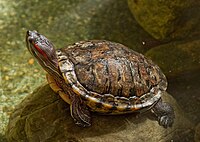
Photo from wikipedia
This study was aimed at determining the prevalence and characterising the strains of Salmonella species in various captive reptiles in the Czech Republic. A total of 211 samples of cloacal… Click to show full abstract
This study was aimed at determining the prevalence and characterising the strains of Salmonella species in various captive reptiles in the Czech Republic. A total of 211 samples of cloacal swabs from lizards, chelonians and snakes, and 14 swabs from terraria surfaces were collected between November 2014 and July 2015. After isolation according to the reference method (EN ISO), Salmonella spp. isolates were characterised using serotyping and macrorestriction analysis followed by pulsed field gel electrophoresis and antimicrobial susceptibility testing. Altogether, 39 isolates were obtained from 29 (19%) reptiles and from terraria surfaces. Among the different reptilian species, Salmonella spp. were found in 22 (25.6%) lizards, three (17.6%) snakes and four (8%) chelonians with 31 isolates classified as Salmonella enterica subspecies enterica and eight isolates classified as Salmonella enterica subsp. salamae. In total, 14 different serotypes were detected, with the most frequent serotypes being Salmonella Oranienburg, S. Fluntern, S. Tennessee and S. Cotham. Resistance to one antimicrobial agent (ampicillin, tetracycline or streptomycin) was detected in five isolates. The results of the macrorestriction analysis within the serotype groups showed varying level of heterogeneity. This study confirms that reptiles kept as pets can be both carriers and reservoirs of Salmonella spp., and that they can harbour various serotypes with intermittent excretion of the bacteria in faeces. Half of the detected serotypes have been involved in human reptileassociated salmonellosis cases in the past. S. enterica subsp. salamae serotype O:1,13,23;H:z29;H:1,5, monophasic S. enterica subsp. salamae serotype O:40;H:g,t;H:– and its biphasic form (S. enterica subsp. salamae serotype O:40;H:g,t;H:1,5) have apparently been isolated from reptiles for the first time in this study.
Journal Title: Veterinarni Medicina
Year Published: 2017
Link to full text (if available)
Share on Social Media: Sign Up to like & get
recommendations!